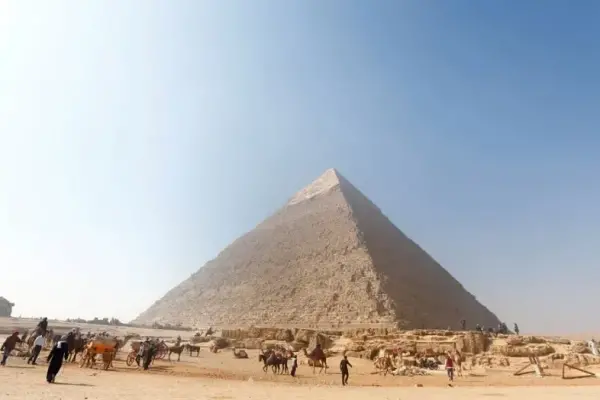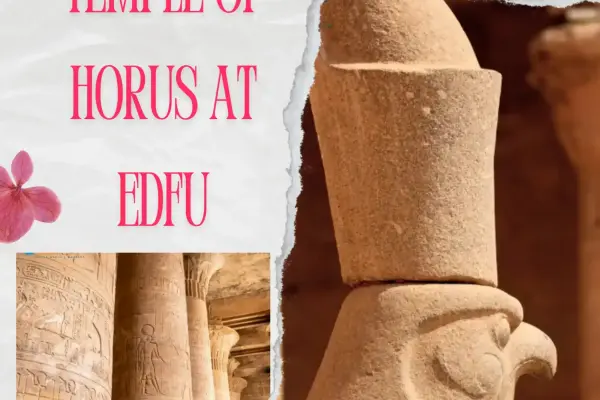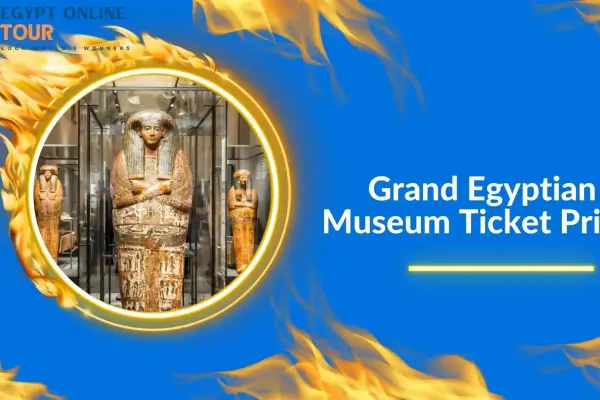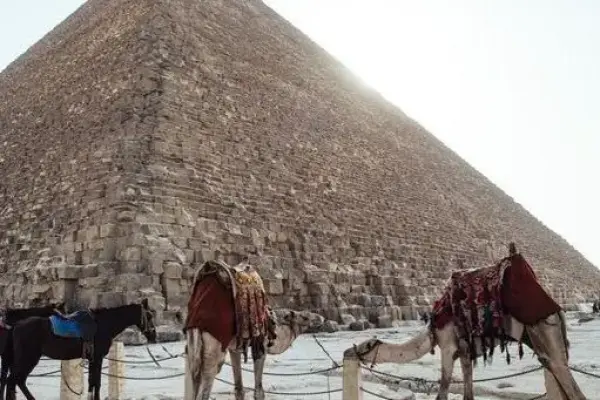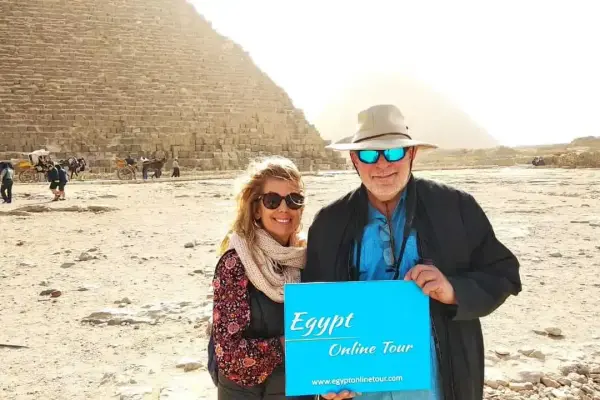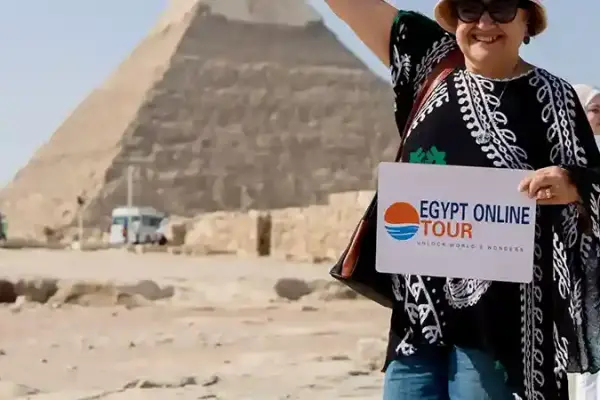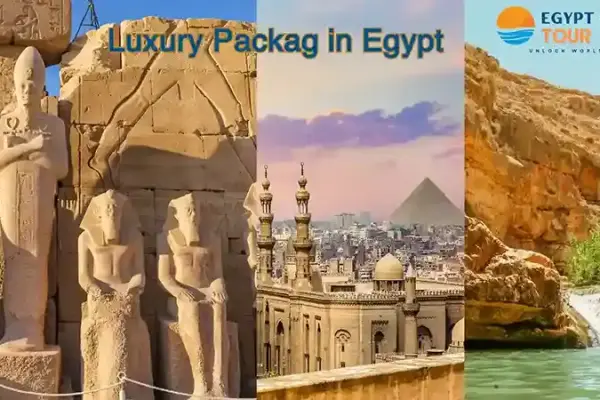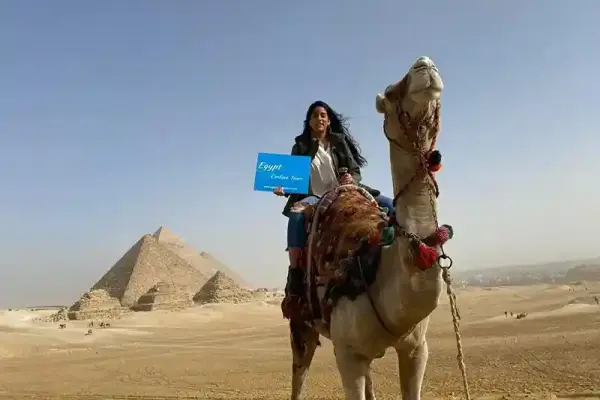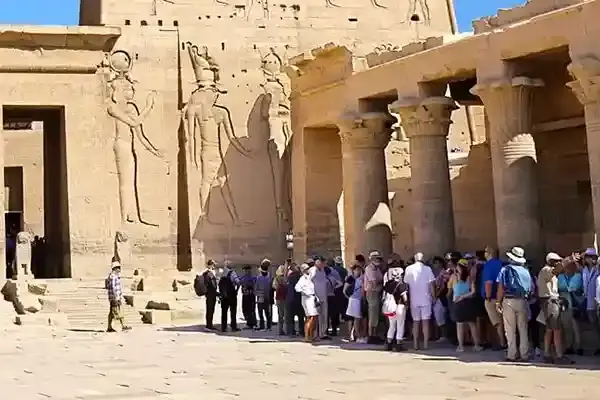If you're a history enthusiast and eager to explore the wonders of ancient Egypt, the Temple of Horus at Edfu is a must-visit! Located in the city of Edfu on the west bank of the Nile, it is one of the best-preserved temples in Egypt. Built during the Ptolemaic era to honor Horus, the ancient Egyptian god of protection and power, this temple is a true masterpiece.
But it’s not just an architectural wonder – it also narrates the epic battle between good and evil, symbolized by Horus and his uncle Set. As you step inside, you'll feel like you've been transported back in time, surrounded by intricately carved walls that offer a glimpse into the religious life and beliefs of ancient Egypt.
Table of contents [Show]
-
Temple of Horus at Edfu history
- Who discovered the Temple of Horus?
- Why was the temple of Edfu built?
- Why is the Temple of Horus at Edfu important?
- Why Visit the Temple of Horus at Edfu?
- Is the Edfu Temple worth visiting?
- Design of Edfu Temple
- Architectural Secrets & Stories Etched in Stone
- The layout of Edfu Temple
- Temple of Horus at Edfu inside
- Getting to the Temple of Horus
- Temple of Horus at Edfu
- Temple of Horus at Edfu tickets
- Tours to Edfu Temple
- Tips when visiting Edfu Temple
- Facts About the Temple of Horus at Edfu
- How do I get to the Temple of Horus?
Where is the temple of Edfu located?
The Temple of Edfu is located on the west bank of the Nile River in the city of Edfu, Upper Egypt. During the Hellenistic period, the city was known as "Apollonopolis Magna."
The temple sits about 115 km south of Luxor and 105 km north of Aswan. It is one of the best-preserved ancient Egyptian temples, attracting visitors eager to explore its rich history and impressive architecture.
Temple of Horus at Edfu history
The Temple of Horus at Edfu is located on the west bank of the Nile in the city of Edfu, Upper Egypt. This ancient city, founded around 3000 BCE, was a major center for the worship of Horus.
The temple we see today was built during the Ptolemaic period, with construction beginning on August 23, 237 BCE, under Ptolemy III and completed about 180 years later during the reign of Ptolemy XII around 57 BCE.
What makes this temple truly special is its remarkable state of preservation. It stands as one of the best-preserved temples from ancient Egypt, showcasing a fascinating blend of traditional Egyptian architecture with Hellenistic influences.
Walking through its grand halls and intricate hieroglyphs offers a rare glimpse into ancient Egypt's religious and cultural world.
Who discovered the Temple of Horus?
The Temple of Horus at Edfu lay hidden beneath layers of desert sand and Nile silt for centuries, waiting to be uncovered. It wasn’t until 1860 that French Egyptologist Auguste Mariette rediscovered this ancient treasure. His excavations revealed one of the best-preserved temples in Egypt, allowing us to step back in time and admire its breathtaking architecture and intricate carvings. Thanks to Mariette’s dedication, we can now experience the magic of this incredible temple firsthand!
Why was the temple of Edfu built?
The Temple of Edfu stands as a remarkable testament to ancient Egyptian religious and architectural brilliance, built to serve multiple spiritual and cultural purposes.
- A Center for Horus Worship, The temple was dedicated to Horus, the protector of the pharaoh and a symbol of power and justice in ancient Egypt.
- A Site for Rituals and Festivals, It hosted major religious celebrations, including the festival where the goddess Hathor traveled to meet Horus, symbolizing fertility and prosperity.
- To be a record of Egyptian Mythology, The temple walls depict the legendary battle between Horus and Set, offering insights into ancient religious beliefs.
- A Cultural Landmark in the Ptolemaic Era, The temple reflects a blend of Egyptian and Greek influences, as the city was known as "Apollonopolis Magna," linking Horus to Apollo.
- One of the Best-Preserved Temples, Today, it remains one of the most intact ancient Egyptian temples, providing visitors with a glimpse into the grandeur of its architecture and art.
Read about: Did Thoth Built The Pyramids
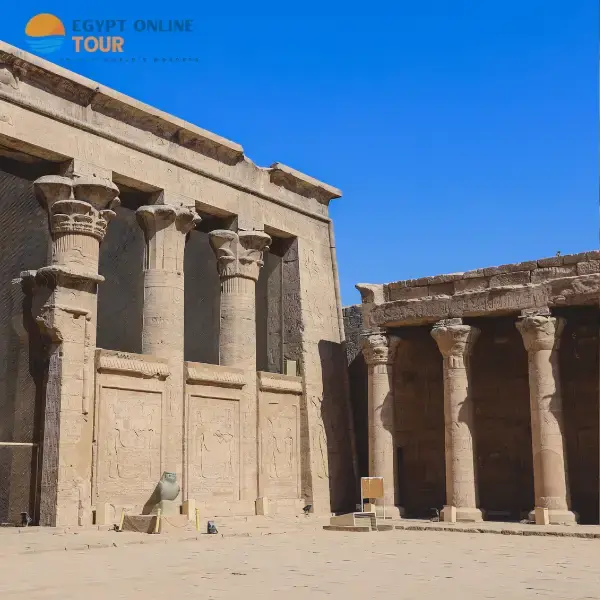
Why is the Temple of Horus at Edfu important?
If you're a history lover or planning a trip to Egypt, then the Temple of Horus at Edfu should definitely be on your must-visit list! But what makes it so special? Let’s find out!
An Architectural Masterpiece
Imagine walking through a temple that’s over 2,000 years old and still in incredible condition! Built between 237 and 57 BC during the Ptolemaic period, the Temple of Horus at Edfu is one of the best-preserved ancient temples in Egypt. Its grand design showcases the brilliance of ancient Egyptian architecture, making it a truly breathtaking sight.
A Sacred Place of Worship
This temple was dedicated to Horus, the falcon-headed god of protection and victory. It served as a major religious center, hosting large festivals, including the Sacred Marriage Festival of Horus and Hathor. This event was one of the most significant religious celebrations in ancient Egypt.
The temple's walls are covered with detailed carvings that tell fascinating stories of Egyptian mythology, including the legendary battle between Horus and the evil god Set. These inscriptions are not just art—they are a historical record that offers deep insights into the beliefs and traditions of ancient Egyptians.
A Journey Back in Time
One of the best things about visiting Edfu Temple is the magical atmosphere that makes you feel like you've traveled back in time. You can even reach it through a scenic Nile cruise between Luxor and Aswan, adding an extra touch of adventure to your trip.
Rediscovering Its True Colors After Thousands of Years!
Recent restoration projects have revealed the temple’s original vibrant colors, hidden for centuries under layers of dust and soot. Now, for the first time in thousands of years, we can see the temple as it looked in ancient times—making your visit even more exciting!
Why You Should Visit the Temple of Horus in Edfu
- Incredible Preservation – Unlike many other ancient temples that have suffered damage over time, Edfu Temple remains remarkably intact, giving you a rare chance to see an Egyptian temple as it looked thousands of years ago.
- Breathtaking Architecture – From its massive entrance pylon to the towering columns of its hypostyle hall, this temple showcases the impressive engineering and artistry of the ancient Egyptians.
- Fascinating Mythology – The temple is dedicated to Horus, the falcon-headed god, and its walls are covered with stunning hieroglyphics that tell the epic story of his battle against Set. If you love ancient myths, this place will bring history to life for you!
- Peaceful Atmosphere – Unlike some of Egypt’s busier tourist sites, Edfu Temple offers a more relaxed and immersive experience, allowing you to explore at your own pace without feeling rushed.
Why Visit the Temple of Horus at Edfu?
Visiting the Temple of Horus isn’t just a historical tour—it’s a journey into a civilization that shaped the world, leaving behind an extraordinary legacy to explore today. Here’s why a visit to this magnificent site should be on your travel list:
- One of the best-preserved temples in Egypt, allowing you to see intricate carvings, massive columns, and original details up close.
- A glimpse into ancient Egyptian mythology, with walls that narrate the legendary battle between Horus and Set, giving you a deeper understanding of their beliefs.
- Stunning architecture blending traditional Egyptian design with Hellenistic influences, making it a unique masterpiece of the Ptolemaic era.
- A site of great religious and cultural significance, once home to grand festivals like the "Sacred Reunion," where Hathor traveled from Dendera to visit Horus in Edfu.
- An unforgettable travel experience, easily accessible via scenic Nile cruises, offering breathtaking views along the way.
Check out our exclusive Egypt tour packages, to make the most of your visit to this magnificent site and explore more of Egypt's ancient wonders!
Is the Edfu Temple worth visiting?
Absolutely! The Temple of Horus at Edfu is one of the best-preserved temples from ancient Egypt, making it a must-visit for history lovers. Its towering walls, intricate carvings, and grand halls offer an immersive journey into the past. Whether you're fascinated by mythology, architecture, or simply love exploring ancient wonders, this temple promises an unforgettable experience!
Design of Edfu Temple
The Temple of Horus at Edfu is a masterpiece of ancient Egyptian architecture, built with incredible precision and symbolism. Its grand entrance, flanked by massive pylons, is adorned with carvings depicting the legendary battle between Horus and Set, setting the stage for the temple’s spiritual significance.
Stepping inside, you’ll find a spacious courtyard surrounded by 32 towering columns, which once hosted grand religious ceremonies. At the heart of the temple lies the Sanctuary of Horus, where a sacred granite shrine once housed the god’s statue. Traces of original vibrant colors and golden decorations still remain, giving a glimpse into its former grandeur.
More than just stone walls, Edfu Temple is a living testament to the rituals, beliefs, and artistry of ancient Egypt, offering a fascinating journey through time.
The Temple of Horus at Edfu is truly a marvel of ancient Egyptian architecture, crafted with a perfect mix of open courtyards and closed spaces, creating a beautiful balance that tells us a lot about how the Egyptians designed their sacred places. But it’s not just about stunning architecture – this temple is also a gateway into the spiritual world of ancient Egypt.
Hieroglyphics: More Than Just Decoration
The temple’s walls are covered with detailed hieroglyphics that aren’t just decorative but tell the incredible story of the battle between Horus and Set. This battle symbolized the constant struggle between good and evil, and these carvings were a reflection of the spiritual beliefs of the time. It’s like the walls are telling us an ancient story of power, divinity, and the balance of the universe.
The Magical Chamber and Protective Rituals
One of the most fascinating parts of the temple is a special chamber believed to have been used for magical rituals. Inside, there are inscriptions that show how the Egyptians believed in using spells and charms to protect themselves from evil forces. The idea that the temple was not only a place of worship but also a spiritual shield makes it even more intriguing.
Festivals and Spiritual Gatherings
The temple was also home to grand religious festivals. One of the most important was the Journey of Hathor, where the goddess would travel from her temple in Dendera to reunite with Horus at Edfu. This journey was more than just a ritual; it was a time of music, celebrations, and a deep connection with the divine. It’s a reminder of how temples like Edfu weren’t just physical structures but vibrant centers for community, faith, and connection with the gods.
In short, the Temple of Horus at Edfu is more than just a beautiful building – it’s a key to understanding the spiritual and cultural life of ancient Egypt, filled with stories, rituals, and beliefs that shaped a civilization.
Read more about the Architectural achievements of Ancient Egypt
The layout of Edfu Temple
The Temple of Horus at Edfu is designed as follows:
- The Grand Entrance (Pylon): The temple welcomes visitors with an impressive façade featuring two towering pylons, each standing 36 meters high. These pylons are decorated with intricate carvings depicting Horus' victory over his rival, Set, emphasizing the temple’s religious significance.
- The Open Courtyard: Stepping inside, you’ll find a spacious courtyard surrounded by 32 beautifully decorated columns. This area was the heart of religious gatherings and festivals, where priests and worshippers would come together to celebrate major events.
- The Hypostyle Hall: Beyond the courtyard lies a grand hall filled with rows of massive columns, leading deeper into the temple. This transitional space creates a sense of movement, drawing visitors towards the temple’s most sacred areas.
- The Sanctuary (Holy of Holies): At the very heart of the temple is the Sanctuary, the holiest chamber, where a black granite shrine once housed a sacred statue of Horus. Only priests were allowed inside, as it was considered the most divine space in the entire complex.
The layout of Edfu Temple was designed not just for aesthetics but as a spiritual journey—guiding visitors through different levels of sacred space until they reached the divine core of the temple.
maybe like: What Are 3 Major Achievements of Ancient Egypt
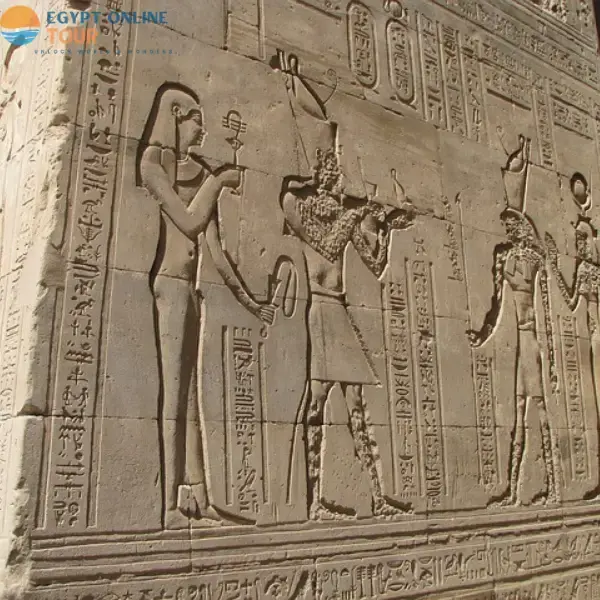
Temple of Horus at Edfu inside
The Temple of Horus at Edfu stands as one of the most well-preserved temples of ancient Egypt, offering a glimpse into the architectural brilliance and spiritual life of the pharaohs. As you pass through the towering gateway, flanked by two impressive pylons standing at 36 meters high, you enter a vast courtyard once used for grand religious ceremonies and sacred rituals.
Moving further inside, the temple’s Hypostyle Hall is a masterpiece in itself, with 12 massive columns adorned with intricate carvings that depict legendary tales of Horus and ancient religious practices.
Every inch of the walls is covered with hieroglyphs, narrating stories of divine battles and ceremonial traditions, making it feel like stepping into a living piece of history.
Discovering the Heart of the Temple
At the heart of the temple lies the Sanctuary of Horus, the holiest part of the complex. Here, the sacred granite naos once housed the statue of Horus, an object of worship during elaborate rituals.
Thanks to modern restoration efforts, visitors can now witness the original vibrant colors of the inscriptions, providing a rare look at how the temple appeared thousands of years ago.
For travelers looking for an immersive historical journey, exploring the temple as part of an Egypt Classic Tours itinerary is a fantastic way to experience not only Edfu but also other breathtaking archaeological wonders across the country.
Read about: Can You Go Inside The Great Pyramids
Getting to the Temple of Horus
To visit the Temple of Horus in Edfu, you have several options depending on your starting point and preferred experience.
- One of the most common ways is by train, with routes connecting Edfu to Luxor and Aswan.
- Upon arrival at Edfu station, you can take a traditional horse-drawn carriage (known as a "hantour") or a taxi to the temple.
- For a more scenic and immersive journey, many Nile cruises include Edfu as a stop, allowing visitors to arrive by boat and experience the beauty of the river along the way.
- If you prefer flexibility and comfort, private tours and car rentals are also available, often including a knowledgeable guide who can provide historical context and insights about the temple.
No matter how you get there, a visit to the Temple of Horus offers a fascinating glimpse into ancient Egyptian history.
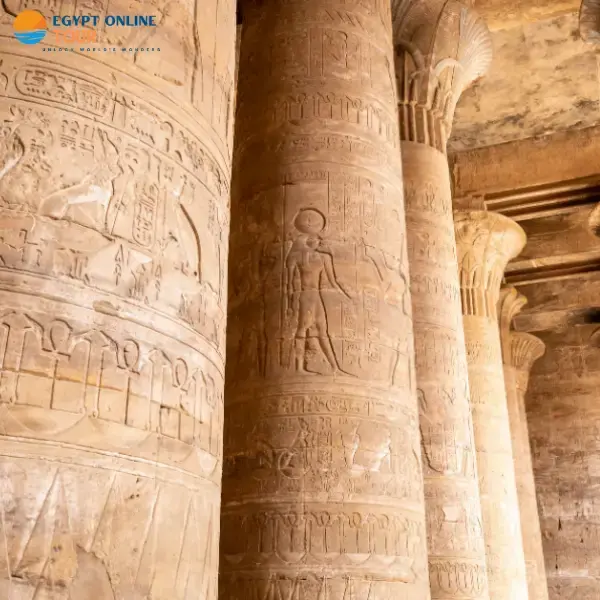
Temple of Horus at Edfu
The Temple of Horus at Edfu is one of the best-preserved ancient Egyptian temples, offering a fascinating glimpse into the country’s rich history. It was built during the Ptolemaic period between 237 and 57 BC, it was dedicated to Horus, the falcon-headed god of protection and power.
The temple’s massive walls are adorned with intricate hieroglyphics that tell legendary stories of Horus’ battle with the god Set. Recent restoration work has revealed the temple’s original vibrant colors, bringing its ancient carvings to life in a whole new way.
If you’re planning a visit, the best time to go is early in the morning to avoid crowds and fully appreciate its grandeur. The Temple of Horus at Edfu is open daily and easily accessible by tourist boats or trains from Luxor and Aswan, making it a must-visit destination for history lovers and adventure seekers alike.
Temple of Horus at Edfu tickets
If you're planning to visit the Temple of Horus at Edfu, knowing the ticket details and opening hours will help you make the most of your trip, The temple is open daily from 7:00 AM to 4:00 PM, and it’s best to arrive early to avoid crowds and enjoy a more peaceful experience.
Ticket Prices:
- Foreign Visitors: EGP 550 for adults and EGP 275 for students.
- Egyptians and Arab Nationals: EGP 40 for adults and EGP 20 for students.
For a hassle-free visit, consider booking your tickets online in advance. Egypt Online Tours offer guided tours, allowing you to explore the temple’s rich history with expert insights. One great option is the 8 Days Cairo, Luxor, Aswan Classic Tours, which takes you on an unforgettable journey through Egypt’s most iconic landmarks, including the Temple of Horus at Edfu.
Don’t forget to keep your ticket with you throughout your visit, and check for any updates on timings or prices before heading out.
Temple of Horus today
Today, the Temple of Horus at Edfu stands as one of the best-preserved ancient Egyptian temples, offering visitors a fascinating glimpse into the grandeur of the past. Thanks to recent restoration efforts led by Egypt’s Ministry of Tourism and Antiquities, in collaboration with Julius-Maximilians-Universität Würzburg, the temple’s original vibrant colors—once hidden beneath layers of dust and soot—have been uncovered.
These discoveries provide fresh insights into the artistry and symbolism of ancient Egyptian temples.
Now, thousands of visitors explore Edfu to admire its stunning carvings, learn about the rituals once performed within its walls, and experience the timeless magic of one of Egypt’s most remarkable historical sites. Consider the 8 Days Cairo to Abu Simbel and Back Overland for a more in-depth look at Egypt Tours.
Tours to Edfu Temple
If you're fascinated by Egypt's ancient history and majestic temples, visiting the Temple of Horus at Edfu is a must! It offers an incredible opportunity to explore the grandeur of Egyptian civilization, Here is the types Tours to Edfu Temple:
- Luxor Day Tours Luxor, If you're in Luxor, you can enjoy a day trip to the Temple of Horus at Edfu, just a 1.5- to 2-hour drive away. These tours often combine visits to other amazing sites, like the Temple of Kom Ombo, making it a fantastic way to see multiple historic locations in one day.
- Nile Cruise Packages, For those who prefer a scenic experience, many tours like Luxor and Aswan Nile Cruises include stops at Edfu Temple along the way. This allows you to visit the temple while enjoying a relaxing cruise between Luxor and Aswan.
- Private Guided Tours, If you want a more personal and in-depth experience, consider booking a private tour with an expert guide. You'll get to learn fascinating details about the temple’s history, the ancient worship of Horus, and the incredible architectural features of the temple.
- Group Tours, For a more affordable option, group tours offer a chance to visit Edfu Temple along with other nearby attractions. This is a great way to meet fellow travelers while exploring the rich heritage of Egypt. Consider our Egypt Adventure Tours to meet your dreams there.
Tips when visiting Edfu Temple
Planning a visit to the Temple of Horus at Edfu? Here are some tips to make your experience even better:
- Choose the right time, Visiting early in the morning or just before closing helps you avoid the midday heat and large crowds.
- Wear comfortable clothing, Light, breathable clothes are best for Egypt’s weather. It’s also a good idea to wear modest clothing if you plan to explore other sites.
- Getting there, In Edfu, local transport options include horse-drawn carriages (hantours) and tuk-tuks. If you prefer more comfort, arranging a private driver in advance is a good idea.
- Ticket prices, Entry fees are reasonable—100 EGP for adults and 50 EGP for students—so have some cash on hand.
- Bring a camera, The temple's carvings and inscriptions are stunning, and you'll want to capture the details. Make sure your phone is charged or bring a camera.
- Consider a tour guide. A local guide can bring the temple’s history to life with fascinating stories and insights you might miss on your own.
- Facilities nearby, There’s a small café and a parking area near the temple, making it easy to take a break before or after your visit.
With these simple tips, you’ll enjoy a smooth and unforgettable trip to one of Egypt’s most well-preserved ancient temples!
Facts About the Temple of Horus at Edfu
The Temple of Horus at Edfu stands on the west bank of the Nile in Upper Egypt, dedicated to Horus, the falcon-headed god, known as Horus of Behdet.
Key Facts About Edfu Temple:
- Its walls are adorned with intricate hieroglyphics that depict the legendary battle between Horus and Set, offering a fascinating glimpse into ancient Egyptian mythology and religious beliefs.
- The temple’s carvings vividly portray the epic battle between Horus and Set, symbolizing the victory of good over evil in Egyptian mythology.
- It was a central hub for grand annual festivals, such as the sacred reunion of Hathor and Horus, in which the goddess Hathor traveled from her temple in Dendera to Edfu in an important religious ritual.
- The design of the temple influenced Western architecture, with a notable example being Temple Works in Leeds, England, which was inspired by the grandeur of this ancient Egyptian marvel.
- It is considered one of the best-preserved ancient Egyptian temples, retaining much of its original detail and offering visitors a unique and immersive look into Egypt’s past.
The Temple of Horus at Edfu is a magnificent testament to the grandeur of ancient Egyptian art, culture, and religion.
Read about: Facts about The Temple of Karnak
FAQs
How do I get to the Temple of Horus?
You have a few options! The most popular way is by taking a Nile cruise between Luxor and Aswan, but you can also go by train, taxi, or join a guided tour from Luxor or Aswan.
When is the best time to visit?
Early morning is the best time to go! You'll avoid the crowds and enjoy cooler temperatures, especially in the summer.
How long does it take to explore the temple?
Usually, a visit takes about 1 to 2 hours, depending on how much time you want to spend admiring the details and carvings.
Can I hire a tour guide?
Yes! You can hire a local guide at the entrance or book a tour with a guide if you're traveling with a group.
Is photography allowed inside?
Yes, but without flash, to help preserve the ancient carvings and colors.
Is there an entrance fee?
Yes, there is a ticket fee, which varies depending on nationality. Tickets are available at the temple entrance.
Is the temple family-friendly?
Absolutely! Kids who love history and mythology will have a great time discovering the stories of the pharaohs and gods.
Are there any facilities nearby?
There are souvenir shops, small cafes, and restrooms near the temple, but options are limited—so it’s a good idea to bring water and a light snack.
Popular Categories
Popular Posts

Top Alexandria Beaches You Must Visit 2026
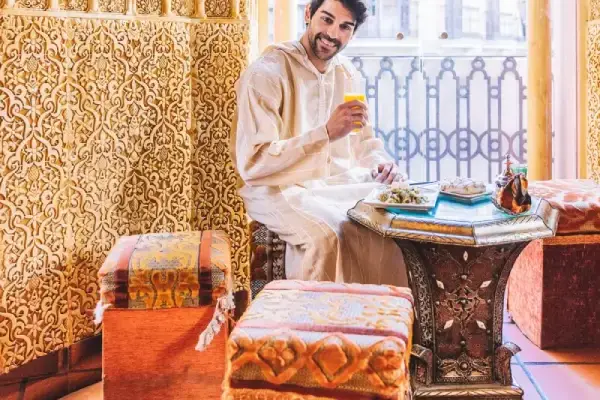
What are the important holidays in Egypt?
